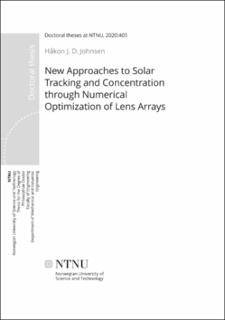| dc.contributor.advisor | Torgersen, Jan | |
| dc.contributor.advisor | Aksnes, Astrid | |
| dc.contributor.author | Johnsen, Håkon Jarand Dugstad | |
| dc.date.accessioned | 2020-12-01T09:53:02Z | |
| dc.date.available | 2020-12-01T09:53:02Z | |
| dc.date.issued | 2020 | |
| dc.identifier.isbn | 978-82-471-9791-2 | |
| dc.identifier.issn | 2703-8084 | |
| dc.identifier.uri | https://hdl.handle.net/11250/2711114 | |
| dc.description.abstract | Solar concentrators are essential for enabling several solar energy applications, including high-efficiency photovoltaic conversion and high-temperature solar thermal energy. These concentrators require accurate solar tracking, commonly performed by rotating them towards the sun, which adds to the bulk and complexity of the system.
In this thesis, we investigate optically tracking the sun using millimeter-scale translation instead of rotating the complete concentrator — a concept known as tracking integration. We show how the performance of these systems can be pushed beyond the current state of the art through a broad exploration of the design space using a custom sequential ray-tracer in combination with memetic multi-objective optimization algorithms. We explore two classes of tracking integration: beam-steering lens arrays that consist of an afocal stack of lens arrays, and microtracking concentrators that concentrate sunlight to an array of discrete focal spots where micro-PV cells can convert the solar energy to electricity. Further, we propose possible étendue-squeezing solar concentrator designs that may benefit from tracking integration.
First, we perform a broad exploration of beam-steering lens array configurations for full-day stationary solar tracking. We identify several promising configurations, including one capable of redirecting sunlight into a < 2◦ divergence half-angle with a 73.4% average yearly efficiency. Second, we identify two microtracking configurations that achieve > 2000x concentration ratio at a two-axis ±60◦tracking range. Finally, we demonstrate a line-focus concentrator with a simulated effective concentration ratio of 218x at a ±1◦ acceptance angle that employs étendue squeezing to go beyond the conventional two-dimensional concentration limit. To the best of our knowledge, this is the first demonstration of how a line-focus concentrator can be directly designed as a three-dimensional concentrator to operate beyond the 2D limit (which is 57x at the ±1◦ acceptance angle). This concentrator, combined with beam-steering lens arrays, may enable the development of a new class of highconcentration trough-like solar concentrators. | en_US |
| dc.language.iso | eng | en_US |
| dc.publisher | NTNU | en_US |
| dc.relation.ispartofseries | Doctoral theses at NTNU;2020:405 | |
| dc.relation.haspart | Paper 1: Johnsen, Håkon Jarand Dugstad; Torgersen, Jan; Aksnes, Astrid. Solar tracking using beam-steering lens arrays. I: Nonimaging Optics: Efficient Design for Illumination and Solar Concentration XV. SPIE - International Society for Optical Engineering 2018 ISBN 9781510620872. | en_US |
| dc.relation.haspart | Paper 2: Johnsen, Håkon Jarand Dugstad; Torgersen, Jan; Aksnes, Astrid. High-concentration wide-angle tracking integration with stacked lens arrays. I: 15th International Conference on Concentrator Photovoltaic Systems (CPV-15). American Institute of Physics (AIP) 2019 ISBN 978-0-7354-1894-3. s. - | en_US |
| dc.relation.haspart | Paper 3: Johnsen, Håkon Jarand Dugstad; Aksnes, Astrid; Torgersen, Jan. Pushing the limits of beam-steering lens arrays. Proceedings of SPIE, the International Society for Optical Engineering 2019 ;Volum 11120. s. | en_US |
| dc.relation.haspart | Paper 4: Johnsen, Håkon Jarand Dugstad; Aksnes, Astrid; Torgersen, Jan. High-performance stationary solar tracking through multi-objective optimization of beam-steering lens arrays. Optics Express 2020 ;Volum 28.(14) s. 20503-20522 | en_US |
| dc.relation.haspart | Paper 5: Johnsen, Håkon Jarand Dugstad; Aksnes, Astrid; Torgersen, Jan. Beyond the 2D limit: Étendue-squeezing line-focus solar concentrators. Optics Letters, 2020. In press. | en_US |
| dc.title | New approaches to solar tracking and concentration through numerical optimization of lens arrays | en_US |
| dc.type | Doctoral thesis | en_US |
| dc.subject.nsi | VDP::Teknologi: 500 | en_US |
